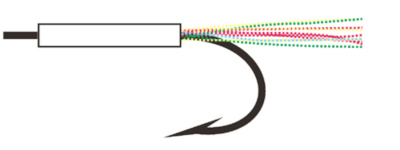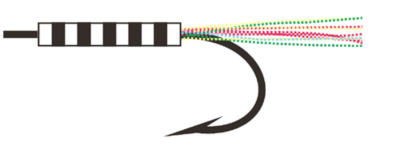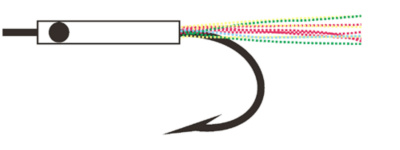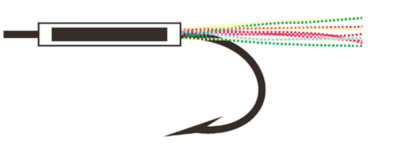In the expeiments
described below, artificial tube lures decorated with the periodic gratings,
eye-spots and longitudinal stripes, named amimetic
stimuli, were tested in the field. As known, the effectiveness of amimetic (non-simulative)
stimuli is determined by the neuroethological mechanisms that are common for the
different sensory guided behavioural responses, both in animal and human.
For more information bout amimetic stimuli, please see these articles:
The testing
lures were made of hard plastic tubes with the diameter of 3-4 mm and the length
of 22-24 mm. The tubes were moved to the single or duble slightly decorated
hooks. The tubes were white, amimetic stimuli were made of black sticky paper
(WTP Inc., # 414). Periodic gratings had 2 mm bands with 2 mm spaces (5 bands,
in total). The diameter of bilateral black eye-spots was 3,0-3,5 mm. Bilateral longitudinal stripes had the width
of 2 mm and the length of 18 mm. In the experiments, lures of the same size
with and without black decorations (see Fig) were compared pairwise.


Two
compared lures, with and without black decorations, were attached to the two
arms of an umbrella rig. Its arms of 10 cm long were made of high quality stainless
wire diameter of 0,3 mm. Umbrella rig was equipped with the low-centered weight
of 10-15 gr (neutral grey color). When retrieving, both compared lures moved in
the horizontal plane at the distance of 6-7 cm each from other.
Perch, Perca fluviatilis, were used as the fish
model.
Note, adult
perch and other visually guided fish can distinguish 1,5-2,0 mm details at an
attack distance up to 15-20 cm under the day light (Richmond et al., 2004).
Compared lures
were presented with the assistance of light spinning rods in the wide (5-10 m) aisles between the coastal aquatic plants, where
perch located mainly at the border of vegetation and clear water. In this case,
perch could attack the nearest lure. To avoid this systematic mistake, compared
lures were presented the same number of times near the left wall of vegetation
and, correspondingly, near the right wall (at the distance of 0,3-0,8 m from
the wall).
Aquatic
plants included mainly yellow water lily (Nuphar
lutea) and numerous pondweeds.
Within
one of the typical sessions of lure presentations, the following results were
obtained. Out of 100 lure presentations, 58 were empty, 10 perch were landed
pairwise. These data were no used in calculation. The remaining 32 perch were
distributed in the following way. 24 perch (marked by sign +) took the lure
with the banded tube. Whereas only 8 perch (marked by sign ) took the lure
without bands. According to the sign test statistical method, n =32, z fact =24, z standard
= 24, p < 0.01. It means that in these tests perch preferred authentically
the lure with the bands.


Similarly,
perch preferred lures with the bilateral eye-spots and lures with the bilateral
longitudinal stripes (see Fig.) to
simple lures.
...
Read more »







